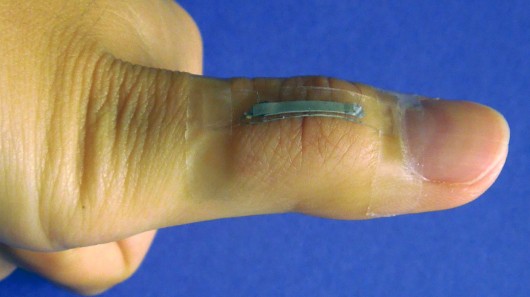Scientist-led conferences at Harvard, Stanford and MIT
-
Minimally invasive multi-channel control system for prosthetics tested
http://www.multivu.com/mnr/65112-alfred-mann-foundation-u-s-marine-subject-fda-study-for-imes-system The Alfred Mann Foundation‘s first subject, a U.S. Marine, will receive its IMES System (implantable myoelectric sensor). The experimental system could be the first minimally invasive, intuitive, multi-channel control system for prosthetics, intended for long term use. It is being studied under the Investigational Device Exemption regulations of the U.S. Food and Drug…
-
Sensors detect radiation complications early, at home
http://www.ncbi.nlm.nih.gov/pubmed/24395986 Susan Peterson and colleagues at MD Anderson have completed a feasibility study showing that equipping head and neck cancer patients with home-based sensors can identify dehydration during radiation treatment. Physicians reviewed patients’ information daily using CYCORE (CYberinfrastructure for COmparative Effectiveness REsearch), a software-based platform to collect and manage data from multiple systems through a suite of home-based and…
-

Wearable, multifunctional, silver nanowire sensor for prosthetics, robotics
http://pubs.rsc.org/en/Content/ArticleLanding/2014/NR/C3NR05496A#!divAbstract North Carolina State University researchers have developed a thumb joint mounted, multifunctional sensor using silver nanowires that measures strain, pressure, human touch and bioelectronic signals. With potential biomedical, military and athletic applications, the sensor can be used for prosthetics, robotic systems and flexible touch panels. “The technology is based on either physical deformation or…
-

Smart contact lens prototype to monitor glucose
http://googleblog.blogspot.com/2014/01/introducing-our-smart-contact-lens.html Google is testing a smart contact lens that’s built to measure glucose levels in tears. It uses a tiny wireless chip and miniaturized glucose sensor embedded between two layers of soft contact lens material. The prototype can generate a reading once per second. They are investigating the potential of integrating tiny LED lights that…
-
K supercomputer runs largest neural simulation to date
http://www.telegraph.co.uk/technology/10567942/Supercomputer-models-one-second-of-human-brain-activity.html RIKEN, Okinawa Institute of Science and Technology, and Forschungszentrum Jülich researchers have used Japan’s K computer to run the longest brain simulation to date.With 705,024 processor cores, running at speeds of over 10 petaflops, it is ranked the world’s fourth-most powerful computer. Using Neural Simulation Technology software and 92,944 of its processors, the computer replicated one second of…
-
Study: Surgeons view detailed, real-time 3D holograms of heart
http://www.realviewimaging.com/ Philips and RealView Imaging recently completed a clinical study demonstrating the feasibility of using live 3D holographic visualization and interaction technology to guide minimally-invasive structural heart disease procedures. RealView’s technology was used to display interactive, real-time 3D holographic images acquired by Philips’ interventional X-ray and cardiac ultrasound systems. In addition to viewing the patient’s heart on a 2D screen,…
-
Ultrasound stimulation enhanced sensory performance in human brain
http://www.nature.com/neuro/journal/vaop/ncurrent/full/nn.3620.html Virginia Tech Carilion Research Institute scientists, led by Professor William Tyler, have demonstrated that ultrasound directed to a specific region of the brain can boost performance in sensory discrimination. This is the first example of low-intensity, transcranial-focused ultrasound modulating human brain activity to enhance perception. The scientists delivered focused ultrasound to an area of the cerebral…
-
Smart contact lens with potential to monitor intraocular pressure
http://www.nature.com/ncomms/2014/140107/ncomms3982/full/ncomms3982.html Swiss Federal Institute of Technology scientists have developed a light, flexible, ultra-thin membrane with the potential to detect intraocular pressure in glaucoma. Researchers claim that the technology “could offer significant advantages over existing solutions in terms of thickness, lightness, and transparency and, hence, comfort for the patient.” The device consists of layered polymer films, one…
-
Nerve stimulation for sleep apnea
http://www.nejm.org/doi/full/10.1056/NEJMoa1308659 Current sleep apnea treatments are intrusive and uncomfortable. University of Pittsburgh Professor Patrick J. Strollo has developed a “pulse generator” which, when surgically implanted, senses one’s effort to breath. It then sends pulse stimulation to the hypoglossal nerve, controlling the neck muscles that keep the airway open, preventing collapse. Standard treatment for sleep apnea is…
-
Baby onesie tracks breathing, sleep, movement, temperature
http://mimobaby.com/ Sensor based baby monitoring is receiving a lot of exposure at CES. One such monitor, by Mimo baby, includes three parts: the Kimono, the Turtle and the Lilypad station. The Kimono is a cotton onesie, with machine washable sensors, worn by a baby when sleeping. It houses the Turtle, which tracks a baby’s respiration,…
-
Digital Health. Wearable Tech. Quantified Self. Curated.
Wearable tech. Digital health. Quantified self. mHealth. Connected home. Internet of things. However described, the phenomenon of using sensor technology to monitor, adapt, diagnose, gamify, and improve our health is in full swing at the Consumer Electronics Show. As sensors become better and cheaper, signal processing becomes more sophisticated, and mobile technology becomes ubiquitous, the revolution…
-
Washington University developing interactive brain wiring diagram
http://www.nytimes.com/2014/01/07/science/the-brain-in-exquisite-detail.html?smid=tw-nytimes Computers and mathematical tools for analyzing vast amounts of data are making the goal of mapping the brain possible, as reported in today’s New York Times. Professor Deanna Barch leads Washington University’s project, which requires 1,200 healthy people, ages 22 to 35, to spend four hours over two days in a customized MRI machine. The…
Got any book recommendations?